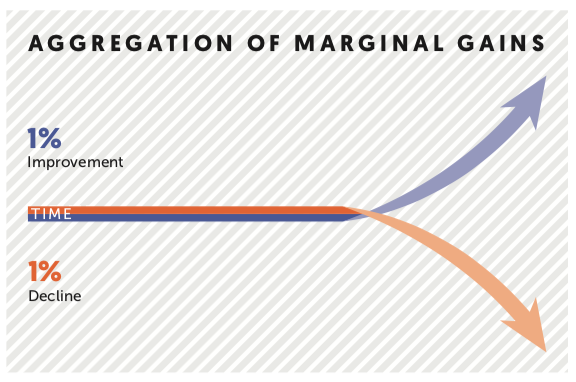
Small is bountiful. Adopt a 1% better plan for dramatic personal change, writes Jared Bleak
You want to lose that pesky 10lbs. You want to get in better shape and improve your energy levels. You want to begin meditating and become more mindful as a leader. You want to improve your relationship with your son or with another key person in your life.
We all want to get better – to improve ourselves. And every New Year, many of us set some very big goals, perhaps hoping to reach or achieve what we’ve been unsuccessful at in the past.
I was struck by this quotation from the legendary US basketball coach John Wooden:
When you improve a little each day, eventually big things occur. When you improve conditioning a little each day, eventually you have a big improvement in conditioning. Not tomorrow, not the next day, but eventually a big gain is made. Don’t look for the big, quick improvement. Seek the small improvement one day at a time. That’s the only way it happens – and when it happens, it lasts.
Is one reason for our iterative failure to change because we set big hairy goals and then falter over time because the challenge becomes too daunting? What if instead we just start very small and get a little bit better every day? Getting better by just 1% consistently can build to tremendous improvements, and over time can make a big difference to our success.
It’s called the principle of ‘aggregate marginal gains’, and is the idea that if you improve by just 1% consistently, those small gains will add up to remarkable improvement. We see this everywhere in our lives. Saving small amounts of money over time can build big sums with the power of compound interest. Beginning a regular and consistent physical exercise routine will yield impressive gains over time. Small amounts, little improvements, and incremental progress can result in huge increases.
Big change and improvement can be and is achieved by small steps – but always with a grander vision and goal in mind.
Racing away
A prime example is the coaching and leadership of Dave Brailsford, the British Olympic and Team Sky cycling coach. Brailsford believes in the principle, and explained it to his cycling team as “the 1% margin for improvement in everything you do”. When Brailsford began with Team Sky in 2010, no British cyclist had ever won the Tour de France. Yet Brailsford guaranteed that a British cyclist would win the Tour within five years. But it didn’t take anywhere near that long. In 2012, Bradley Wiggins became the first British cyclist to win the race. That same year, Brailsford applied his 1% approach to help the British Olympic cycling team win 70% of the gold medals available in the London Olympics. And since then, Team Sky has won the Tour de France several more times. Aggregating marginal gains can help us reach our very lofty goals.
Success is a process
The truth is that our own development as leaders, our success in business, effectiveness as a parent, or any other noteworthy accomplishment is not an event, but the result of a process – a series of little events and choices over time.
So how do we do it? We can start by:
1 Identifying the big goal we want to reach and then dividing it into chunks
2 Setting a goal and planning for what we’ll do daily or weekly – this can be very small (as small as adding just one push up a day or meditating for just a few minutes to begin with, and then adding 30 seconds or a minute at regular intervals)
3 Creating a system of accountability that will help to remind us of the goal and hold us to it
4 Building needed support from friends, co-workers or relatives
5 Establishing a system of follow-up and measurement so we can see progress
Compounding gains
The first trick for success is to keep going in the early days when progress feels slow. Set the time interval that works for you – if 1% a day is too much, try 1% a week or a month. 1% a day compounded over time doubles in 72 days (see graphic above). After a year, you have over 37 times more. And the compounding works even more dramatically as you continue consistently. This is how change happens ‘gradually, and then suddenly’ as illustrated by the slope of the graph. If you are starting at a level ‘1’ today, your 1% improvement is only .01. But as you improve and grow, eventually you will be at a level ‘10’ or even level ‘100’. At that level 100, a 1% improvement is 1 and the whole equation starts to accelerate.
In reverse
Like many rules, it can work both ways. As we apply the principle consistently, we can improve. Unfortunately, the same is true in the negative – if we consistently make choices that make us 1% less, we will also see similar results over time.
Thus, the second trick for success is to be easy on yourself when you fail, as you inevitably will. Failure isn’t a bad choice that can lead to us get worse; it’s just a temporary setback. Forgive yourself, work out why you faltered and then pick it up again. Over time, you will win.
So, as you consider your development as a leader and as a person – rather than starting with big and flashy, think small and consistent. Just consistently get 1% better, and then watch the dramatic results that happen over time.
–
This article first appeared in www.dialoguereview.com
Guest Author: Jared Bleak PhD works with and coaches chief executives and executives of many globally recognized brands. He consults and advises regularly on formulating strategy, change leadership, innovation and creativity, leading transformation and other topics. He is co-author of The Leadership Advantage.

